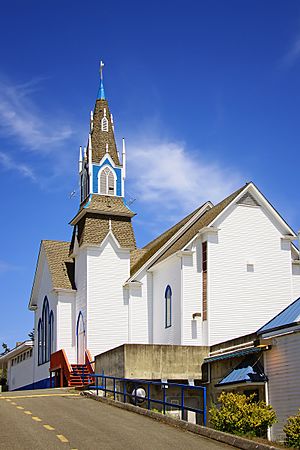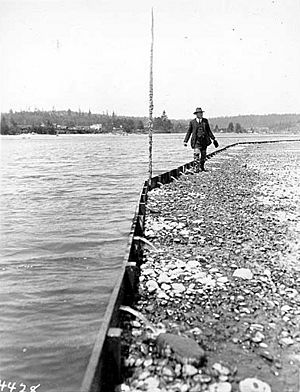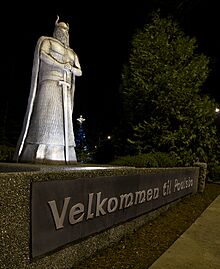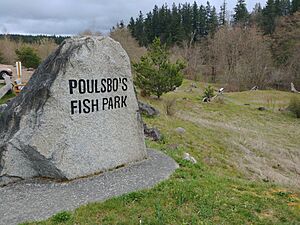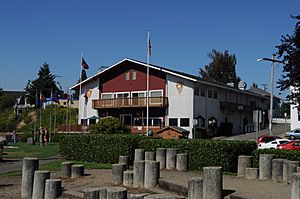Poulsbo, Washington facts for kids
Quick facts for kids
Poulsbo, Washington
č̓uʔč̓uɬac
|
|
|---|---|
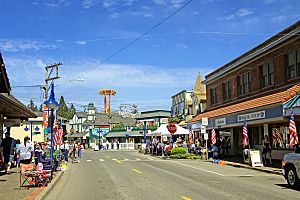
Front Street Northeast
|
|
| Nickname(s):
Viking City, Little Norway
|
|
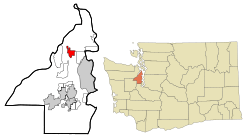
Location of Poulsbo, Washington
|
|
| Country | United States |
| State | Washington |
| County | Kitsap |
| Government | |
| • Type | Mayor–council |
| Area | |
| • Total | 5.37 sq mi (13.91 km2) |
| • Land | 4.74 sq mi (12.27 km2) |
| • Water | 0.63 sq mi (1.64 km2) |
| Elevation | 30 ft (9 m) |
| Population
(2020)
|
|
| • Total | 11,275 |
| • Estimate
(2022)
|
11,891 |
| • Density | 2,528/sq mi (910.20/km2) |
| Time zone | UTC-8 (Pacific (PST)) |
| • Summer (DST) | UTC-7 (PDT) |
| ZIP code |
98370
|
| Area code(s) | 360 |
| FIPS code | 53-55995 |
| GNIS feature ID | 1507605 |
Poulsbo (/ˈpɔːlzboʊ/ PAWLZ-boh) is a city in Washington state. It is located on Liberty Bay in Kitsap County. Poulsbo is the smallest of the four cities in Kitsap County. In 2020, about 11,970 people lived there.
The Suquamish people have lived in this area for thousands of years. They called the area č̓uʔč̓uɬac. After a treaty in 1855, many Suquamish people moved to the Port Madison Indian Reservation.
Poulsbo was started in the 1880s by a Norwegian immigrant named Jørgen Eliason. Other people from Scandinavia, especially Norway, also moved here. They liked the land and resources, which reminded them of their home countries. Boats used to connect Poulsbo to other places. Later, highways took over from the boats.
Today, downtown Poulsbo still looks like a Scandinavian town. This is to honor its early settlers. It's a popular place for tourists to visit. A famous local product is Poulsbo Bread, made at Sluys Bakery. Many visitors come by boat. There are three marinas and a good harbor for boats.
Contents
A Look Back in Time
The Suquamish people lived around Liberty Bay for a very long time. They hunted in the forests and fished in the bays. They also gathered shellfish from the shore. The place where Poulsbo is now was called č̓uʔč̓uɬac, which means "maple trees." The Suquamish had a winter village nearby until the late 1800s.
After the Treaty of Point Elliott was signed in 1855, most Suquamish people moved to the Port Madison Indian Reservation.
Poulsbo was founded in the 1880s by Jørgen Eliason, who was from Norway. Many other Norwegian and Scandinavian immigrants settled here. They felt at home because the area looked like their native countries. In 1886, Iver Brynildsen Moe, an early Norwegian settler, suggested the town needed a post office. He wanted to name it "Paulsbo," after his hometown in Norway. The post office was approved, and Moe became the first postmaster. But officials in Washington, D.C., misspelled the name, and it became "Poulsbo." The city officially became a town on December 18, 1907.
On September 15, 1914, a big fire destroyed many businesses downtown. About one-third of the business area was lost. The cause of the fire was never found. Businesses kept going in other buildings while the downtown was rebuilt. After the fire, new buildings were made with cement instead of wood.
Until World War II, many people in Poulsbo spoke Norwegian as their main language. During the war, the military built about 300 homes for workers. These workers were at the nearby Puget Sound Naval Shipyard in Bremerton. Poulsbo's population almost tripled in three years. This brought many new people, and English became the main language.
On October 22, 1975, King Olav V of Norway visited Poulsbo. This was part of a celebration for 150 years of Norwegian immigration to the United States. His son, Harald, visited 20 years later.
Learning in Poulsbo
Poulsbo has many public schools in the North Kitsap School District. North Kitsap High School, Poulsbo Middle School, Poulsbo Elementary School, and Vinland Elementary School are in the city. Pearson Elementary School is just south of town.
Private schools include Gateway Christian School and West Sound Academy. For college, students can attend Olympic College Poulsbo.
Chief Kitsap Academy is in Suquamish, outside Poulsbo. But it has a Poulsbo mailing address.
Where is Poulsbo?
Location and Surroundings
Poulsbo is in northern Kitsap County. It sits at the north end of Liberty Bay, which is a calm part of Puget Sound. You can find it at 47°44′21″N 122°38′21″W / 47.739137°N 122.639278°W.
Washington State Route 305 starts in northern Poulsbo. It goes southeast about 13 miles to the ferry docks at Bainbridge Island. State Route 3 goes north about 9 miles to Port Gamble. It also goes south about 16 miles to Bremerton.
The United States Census Bureau says Poulsbo covers about 5.27 square miles. About 4.67 square miles are land, and 0.60 square miles are water.
Nearby Places
 |
Hood Canal | Port Gamble | Kingston |  |
| Bangor | Suquamish, Indianola | |||
| Bangor, Silverdale | Scandia, Pearson, Virginia, Keyport | Bainbridge Island |
Poulsbo's Weather
| Climate data for Poulsbo, Washington | |||||||||||||
|---|---|---|---|---|---|---|---|---|---|---|---|---|---|
| Month | Jan | Feb | Mar | Apr | May | Jun | Jul | Aug | Sep | Oct | Nov | Dec | Year |
| Record high °F (°C) | 62 (17) |
71 (22) |
80 (27) |
83 (28) |
92 (33) |
97 (36) |
99 (37) |
101 (38) |
97 (36) |
86 (30) |
70 (21) |
68 (20) |
101 (38) |
| Mean daily maximum °F (°C) | 47 (8) |
49 (9) |
54 (12) |
59 (15) |
65 (18) |
70 (21) |
76 (24) |
77 (25) |
71 (22) |
60 (16) |
51 (11) |
45 (7) |
60 (16) |
| Mean daily minimum °F (°C) | 36 (2) |
35 (2) |
38 (3) |
41 (5) |
46 (8) |
51 (11) |
54 (12) |
55 (13) |
50 (10) |
44 (7) |
39 (4) |
34 (1) |
44 (7) |
| Record low °F (°C) | 12 (−11) |
12 (−11) |
19 (−7) |
28 (−2) |
27 (−3) |
38 (3) |
41 (5) |
39 (4) |
33 (1) |
27 (−3) |
10 (−12) |
7 (−14) |
7 (−14) |
| Average precipitation inches (mm) | 8.89 (226) |
6.22 (158) |
5.95 (151) |
3.57 (91) |
2.46 (62) |
1.69 (43) |
0.86 (22) |
1.03 (26) |
1.55 (39) |
4.89 (124) |
9.39 (239) |
10.07 (256) |
56.57 (1,437) |
Poulsbo's Culture and Landmarks
Local News
The North Kitsap Herald newspaper has been publishing local news since 1901. It covers Poulsbo and the wider Kitsap County area. Peter Iverson, who was once Poulsbo's mayor, started the Herald. Today, Sound Publishing owns the Herald and other local papers.
Important Buildings
The First Lutheran Church opened in 1886. It sits on a hill overlooking downtown Poulsbo. It was first called Førdefjord Lutheran.
The Norseman Statue
The Norseman Statue is a 12-foot tall statue of a Viking. It was created by artist Mark Gale from Tacoma. You can find it at Viking Avenue and Lindvig Way (47°44′50″N 122°39′17″W / 47.74719°N 122.65469°W).
The city asked for this statue to replace an old wooden sign. Local businessman Bill Austin and Mayor Becky Erickson helped with the project. The statue cost $25,000 and was paid for by a private fund. It was shown to the public on November 23, 2012, during a city tree lighting event.
The statue is very strong, made with 500 pounds of steel bars and 5,000 pounds of cement. Its base has the words Velkommen til Poulsbo carved into it, which means "Welcome to Poulsbo."
Parks and Nature
Poulsbo's Fish Park (47°44.862′N 122°39.190′W / 47.747700°N 122.653167°W) is a 40-acre park. A group of community members and local governments, including the City of Poulsbo and the Suquamish Tribe, started the park in 2002.
The park is built around the Dogfish Creek estuary. This is where the creek meets the salt water at the north end of Liberty Bay. As of 2015, the park had 1.5 miles of trails. The city plans to add even more trails.
In the fall, during the salmon run, you can take salmon tours at Fish Park. These tours are led by Washington State University's extension service.
Sister Cities
Poulsbo has two sister cities in Norway:
People of Poulsbo
| Historical population | |||
|---|---|---|---|
| Census | Pop. | %± | |
| 1910 | 364 | — | |
| 1920 | 546 | 50.0% | |
| 1930 | 584 | 7.0% | |
| 1940 | 639 | 9.4% | |
| 1950 | 1,014 | 58.7% | |
| 1960 | 1,505 | 48.4% | |
| 1970 | 1,856 | 23.3% | |
| 1980 | 3,453 | 86.0% | |
| 1990 | 4,848 | 40.4% | |
| 2000 | 6,813 | 40.5% | |
| 2010 | 9,200 | 35.0% | |
| 2020 | 11,970 | 30.1% | |
| U.S. Decennial Census | |||
In 2010, there were 9,200 people living in Poulsbo. About 82.9% of the people were White. About 9.2% were Hispanic or Latino. About 5.7% were Asian.
The average age in the city was 40.2 years old. About 23.8% of residents were under 18. About 19.4% were 65 or older.
Famous People from Poulsbo
- Tarn Adams — creator of the game Dwarf Fortress
- Jack Colletto — American football player
- James W. Douglass — author and peace activist
- Jason Everman — former member of Nirvana
- Richard F. Gordon Jr. — Apollo 12 astronaut
- Aaron Sele — Major League Baseball pitcher
- Scott Shipley — Olympic canoeing medalist
- Ryan Villopoto — professional motocross rider
Main Roads in Poulsbo
 SR 3
SR 3 SR 305
SR 305 SR 307
SR 307
See also
 In Spanish: Poulsbo (Washington) para niños
In Spanish: Poulsbo (Washington) para niños


